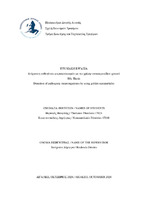| dc.contributor.advisor | HOUHOULA, DIMITRA | |
| dc.contributor.author | Θεριανός, Θεοφάνης | |
| dc.contributor.author | Κωνσταντικάκης, Δημήτριος | |
| dc.date.accessioned | 2024-10-08T06:34:21Z | |
| dc.date.available | 2024-10-08T06:34:21Z | |
| dc.date.issued | 2024-09-26 | |
| dc.identifier.uri | https://polynoe.lib.uniwa.gr/xmlui/handle/11400/7597 | |
| dc.identifier.uri | http://dx.doi.org/10.26265/polynoe-7429 | |
| dc.description.abstract | Η παρούσα μελέτη έγινε επάνω στην χρήση των νανοσωματιδίων χρυσού για τον εντοπισμό παθογόνων μικροοργανισμών. Τα εν λόγω νανοσωματίδια έχουν σημαντικές ιδιότητες που τα καθιστούν πολύτιμα σε πολλές επιστημονικές και άλλες εφαρμογές, όπως η χρήση τους στις βιοεπιστήμες και η εφαρμογή τους για τον εντοπισμό βιομορίων, όπως το γενετικό υλικό. Οι παθογόνοι μικροοργανισμοί διερευνήθηκαν μέσα από κλινικά δείγματα για τον εντοπισμό του γενετικού τους υλικού στην παρούσα εργασία είναι η Salmonella Enteritidis και ο Bacillus Cereus ενώ κάποιοι άλλοι χρησιμοποιήθηκαν ως αρνητικοί μάρτυρες. Σε πρώτη φάση, δημιουργήθηκε το διάλυμα νανοσωματιδίων χρυσού και εκκινητών για τους μικροοργανισμούς - στόχους Salmonella Enteritidis και Bacillus Cereus. Στη συνέχεια απομονώθηκε το DNA των στόχων και μετρήθηκε, και τέλος ακολούθησε η δοκιμασία με HCl για την παρατήρηση των τελικών αποτελεσμάτων. Η μικρότερη ανιχνεύσιμη ποσότητα DNA για την Salmonella Enteritidis ήταν 0,01ng , σε πείραμα που έγινε με αρκετές αραιώσεις. Η αποδιαταξη του DNA έγινε στους 95 ˚C για 5 λεπτά και ο υβριδισμός στους 58 ˚C για 20 λεπτά. Κατά την προσθήκη HCl παρατηρήθηκαν θετικά αποτελέσματα στα 5,7μl. Για τον Bacillus Cereus η μικρότερη ποσότητα DNA που ανιχνεύθηκε ήταν 11,2ng . Η αποδιαταξη έγινε στην ίδια θερμοκρασία αλλά για 10 λεπτά και ο υβριδισμός στους 56 ˚C για 20 λεπτά, ενώ προστέθηκαν 5μl HCl για να παρατηρήσουμε αλλαγή χρώματος. Έτσι, βάσει αυτών των πειραμάτων συνιστούμε να ακολουθούνται αυτές οι παράμετροι σε νέα πειράματα. | el |
| dc.format.extent | 86 | el |
| dc.language.iso | el | el |
| dc.publisher | Πανεπιστήμιο Δυτικής Αττικής | el |
| dc.rights | Αναφορά Δημιουργού - Μη Εμπορική Χρήση - Παρόμοια Διανομή 4.0 Διεθνές | * |
| dc.rights | Attribution-NonCommercial-NoDerivatives 4.0 Διεθνές | * |
| dc.rights.uri | http://creativecommons.org/licenses/by-nc-nd/4.0/ | * |
| dc.subject | Νανοσωματίδια χρυσού | el |
| dc.subject | Ανίχνευση μικροοργανισμών | el |
| dc.subject | Υβριδισμός | el |
| dc.subject | Πλασμονική απορρόφηση | el |
| dc.subject | Χρωματογραφική αλλαγή | el |
| dc.subject | Εκκινητές | el |
| dc.subject | Golden nanoparticles | el |
| dc.subject | Detection of microorganisms | el |
| dc.subject | Hybridization | el |
| dc.subject | Plasmonic absorption | el |
| dc.subject | Chromatographic change | el |
| dc.subject | Primers | el |
| dc.title | Ανίχνευση παθογόνων μικροοργανισμών με την χρήση νανοσωματιδίων χρυσού | el |
| dc.title.alternative | Detection of pathogenic microorganisms by using golden nanoparticles | el |
| dc.type | Πτυχιακή εργασία | el |
| dc.contributor.committee | Batrinou, Anthimia | |
| dc.contributor.committee | Tsakali, Efstathia | |
| dc.contributor.faculty | Σχολή Επιστημών Τροφίμων | el |
| dc.contributor.department | Τμήμα Επιστήμης και Τεχνολογίας Τροφίμων | el |
| dc.description.abstracttranslated | The present study was done on the use of golden nanoparticles for the detection of pathogenic microorganisms. These nanoparticles have important properties that make them valuable in many scientific and other applications, such as their use in the life sciences and their application in locating biomolecules such as genetic material. The pathogenic microorganisms investigated through clinical samples to identify their genetic material in the present work are Salmonella Enteritidis and Bacillus Cereus while some others were used as negative controls. In the first phase, the solution of gold nanoparticles and primers was created for the target microorganisms Salmonella Enteritidis and Bacillus Cereus. The DNA of the targets was then isolated and measured, followed by the HCl assay to observe the final results. The lowest detectable amount of DNA for Salmonella enteritidis was 0.01ng, in an experiment with several dilutions. DNA desegregation was performed at 95 ˚C for 5 min and hybridization at 58 ˚C for 20 min. Upon addition of HCl results were observed at 5.7µl. For Bacillus cereus the smallest amount of DNA detected was 11.2ng. The desegregation was done at the same temperature but for 10min and hybridization at 56˚C for 20min and 5μl of HCl was added to observe color change. Thus, based on these experiments we recommend following these parameters in new experiments. | el |


